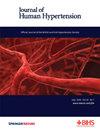红细胞分布宽度作为撒哈拉以南非洲成人高血压患者心血管风险预测因子
IF 3.4
4区 医学
Q2 PERIPHERAL VASCULAR DISEASE
引用次数: 0
摘要
红细胞分布宽度(RDW)量化红细胞大小的变化程度,被认为是不良心血管事件的潜在标志物,可能是评估低资源环境中心血管疾病(CVD)风险的替代标志物。我们将RDW与世界卫生组织(WHO)在加纳和尼日利亚初级卫生保健中心(PHCs)就诊的成年高血压患者的CVD风险评分进行比较,评估RDW作为CVD风险的预测因子。在加纳和尼日利亚选定的初级保健医院接受治疗的高血压成年人参加了一项横断面研究。每个参与者都按照标准方法测量血压(BP)和实验室评估(RDW、总胆固醇和空腹血糖)。我们从研究地点招募了319名年龄在40-74岁之间的成年人。平均(标准差)RDW为13.96(1.1%)。心血管疾病风险评分中位数为8.11%[四分位差(IQR) 4.00 ~ 11.00]。对于血红蛋白(Hb)水平≥12 g/dL的参与者,RDW与年龄呈正相关(r = 0.136;p = 0.042);收缩压(r = 0.183;p = 0.006),舒张压(r = 0.206, p = 0.002)和心血管疾病风险评分(r = 0.166, p = 0.013)。多元线性回归显示RDW与WHO CVD风险评分之间存在独立关联,且呈上升梯度,且在第3个四分位数处最为显著。采用受试者工作特征曲线,c统计量为0.673(95%置信区间:0.618 ~ 0.724),p = 0.031。截止值为bbbb14, RDW的敏感性为81.82%,特异性为55.84%。该研究表明,在Hb水平≥12 g/dL时,RDW可适度预测撒哈拉以南非洲成人高血压患者的心血管疾病风险。本文章由计算机程序翻译,如有差异,请以英文原文为准。

Red cell distribution width as a cardiovascular risk predictor in adults with hypertension in sub-Saharan Africa
Red cell distribution width (RDW) quantifies the degree of variation in erythrocyte size, is identified as a potential marker of adverse cardiovascular events, and may be a surrogate marker for assessing cardiovascular disease (CVD) risk in low-resource settings. We evaluated RDW as a predictor of CVD risk compared to the World Health Organization (WHO) CVD risk score among adults with hypertension attending primary healthcare centers (PHCs) in Ghana and Nigeria. Adults with hypertension attending selected PHCs in Ghana and Nigeria participated in a cross-sectional study. Each participant underwent blood pressure (BP) measurement and laboratory evaluation (RDW, total cholesterol, and fasting blood sugar) following standard methods. We recruited 319 adults aged 40–74 years from the study sites. The mean (standard deviation) RDW was 13.96 (1.1%). The median CVD risk score was 8.11% [interquartile range (IQR) 4.00 to 11.00]. For participants with hemoglobin (Hb) levels ≥ 12 g/dL, RDW showed positive correlations with age (r = 0.136; p = 0.042); systolic BP (r = 0.183; p = 0.006), diastolic BP (r = 0.206, p = 0.002) and WHO CVD risk scores (r = 0.166, p = 0.013). Multiple linear regression showed an independent association between RDW and WHO CVD risk scores with an upward gradient, and was most significant at 3rd quartiles. Using receiver operating characteristic curve, the C-statistic was 0.673 (95% confidence interval: 0.618 to 0.724), p = 0.031. With a cut-off of >14, the RDW demonstrated a sensitivity of 81.82% and specificity of 55.84%. This study shows that at Hb levels ≥ 12 g/dL, RDW modestly predicted CVD risk in adults with hypertension in sub-Saharan Africa.
求助全文
通过发布文献求助,成功后即可免费获取论文全文。
去求助
来源期刊

Journal of Human Hypertension
医学-外周血管病
CiteScore
5.20
自引率
3.70%
发文量
126
审稿时长
6-12 weeks
期刊介绍:
Journal of Human Hypertension is published monthly and is of interest to health care professionals who deal with hypertension (specialists, internists, primary care physicians) and public health workers. We believe that our patients benefit from robust scientific data that are based on well conducted clinical trials. We also believe that basic sciences are the foundations on which we build our knowledge of clinical conditions and their management. Towards this end, although we are primarily a clinical based journal, we also welcome suitable basic sciences studies that promote our understanding of human hypertension.
The journal aims to perform the dual role of increasing knowledge in the field of high blood pressure as well as improving the standard of care of patients. The editors will consider for publication all suitable papers dealing directly or indirectly with clinical aspects of hypertension, including but not limited to epidemiology, pathophysiology, therapeutics and basic sciences involving human subjects or tissues. We also consider papers from all specialties such as ophthalmology, cardiology, nephrology, obstetrics and stroke medicine that deal with the various aspects of hypertension and its complications.
 求助内容:
求助内容: 应助结果提醒方式:
应助结果提醒方式:


